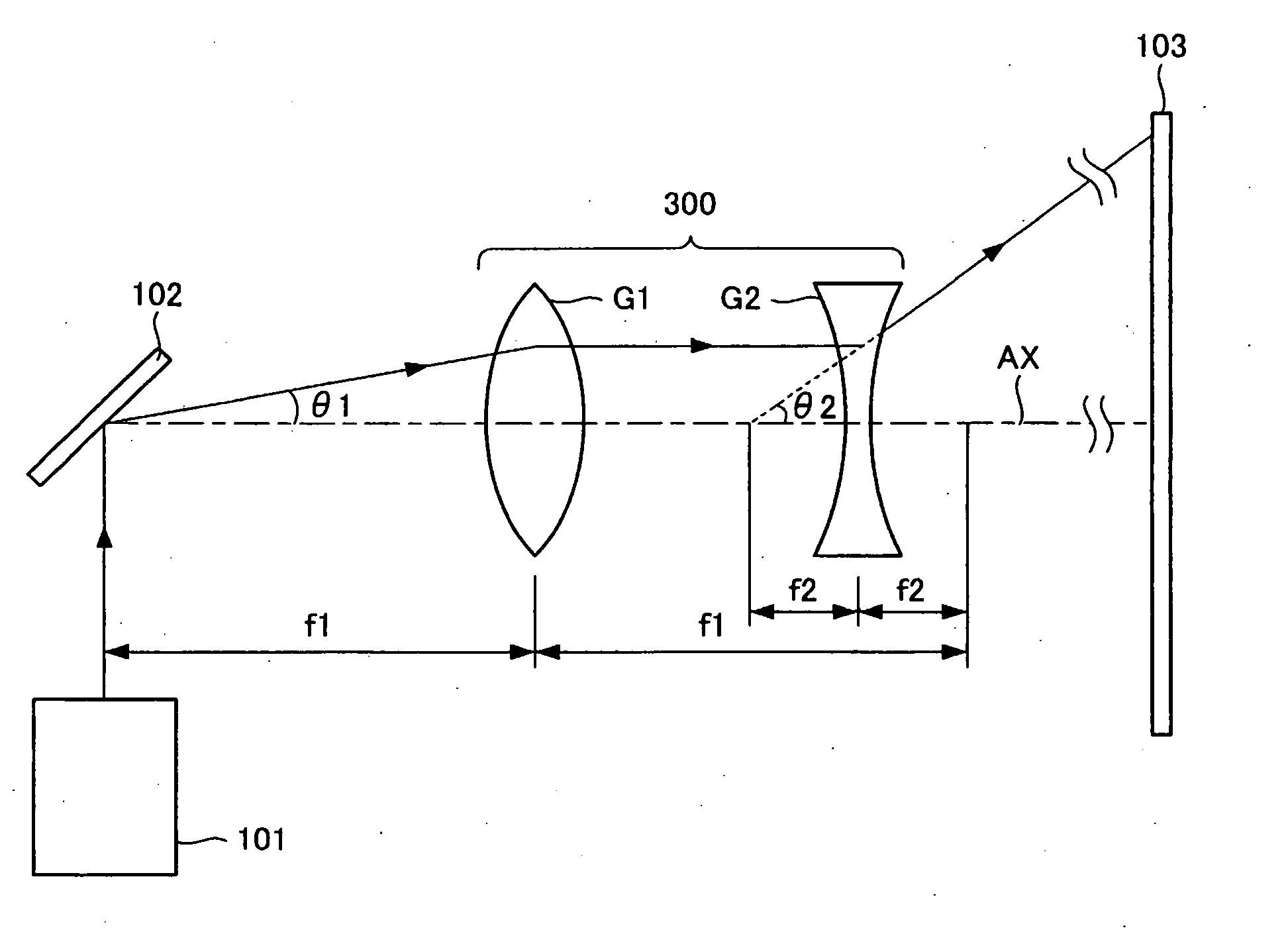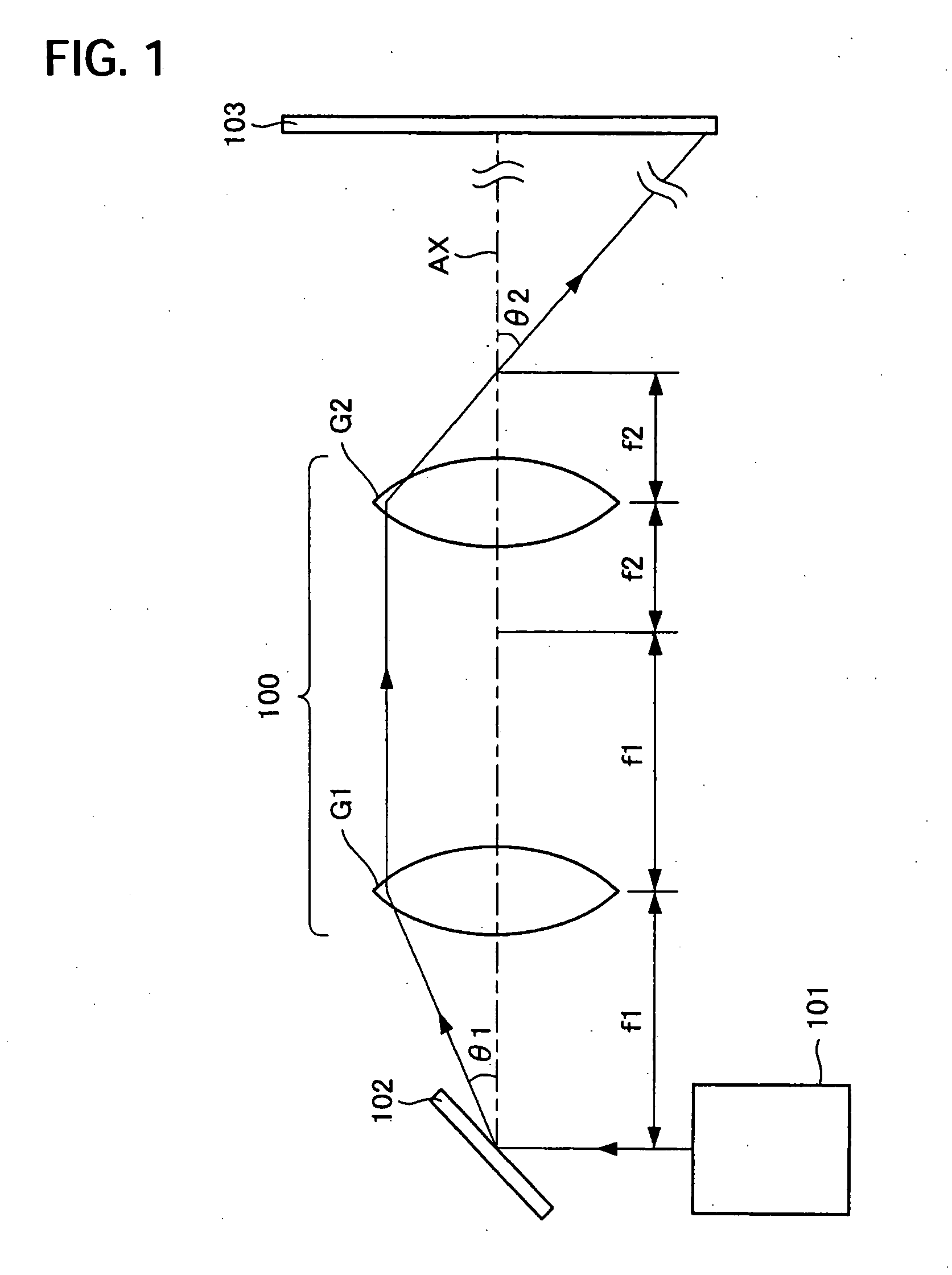Scanning device, laser projector, and optical device
- Summary
- Abstract
- Description
- Claims
- Application Information
AI Technical Summary
Benefits of technology
Problems solved by technology
Method used
Image
Examples
first exemplary embodiment
[0022]FIG. 1 is a schematic showing a rough construction of a scanning device of a first exemplary embodiment of the invention. Laser light, like a beam emitted from a laser light source 101, is incident on a galvanomirror 102, which plays a role of a scanning part 102. The galvanomirror 102 scans the laser light emitted from the laser light source 101 in a two-dimensional direction with a plane mirror that is rotated approximately two perpendicularly crossing directions. The laser light that has been scanned is incident on a scanning optical system 100. The scanning optical system includes a first lens group G1 having a positive refracting power and a second lens group G2 having the positive refracting power, in this order, from the scanning part 102. The first lens group has a focal distance f1 and the second lens group has a focal distance f2.
[0023] The galvanomirror 102 is disposed in the vicinity of a focal position that is located at an incident side of the laser light of the...
second exemplary embodiment
[0026]FIG. 3 is a schematic showing a rough construction of a scanning optical system 300 of a second exemplary embodiment of the invention. In the above-mentioned first exemplary embodiment, the second lens group has a positive refracting power. However, in this exemplary embodiment, the second lens group has a negative refracting power. The same label will be given to the part that is same as described in the above-mentioned first exemplary embodiment and overlapping explanations will be omitted. The scanning optical system 300 includes a scanning part 102, a first lens group G1 having a positive refracting power, and a second lens group G2 having a negative refracting power in this order from the scanning part 102 side. The first lens group has a focal distance f1 and the second lens group has a focal distance f2 (a negative value).
[0027] The galvanomirror 102, which plays a role of the scanning part 102, is disposed in the vicinity of a focal position that is located at an inci...
third exemplary embodiment
[0030]FIG. 5 is a schematic showing a rough construction of a laser projector 500 of a third exemplary embodiment of the invention. A first color laser light source 501R provides a red color laser light (hereinafter called “light R”) modulated in accordance with a picture signal. A second color laser light source 501G provides a green color laser light (hereinafter called “light G”) modulated in accordance with a picture signal. A third color laser light source 501B provides a blue color laser light (hereinafter called “light B”) modulated in accordance with a picture signal. Each color laser light source 501R, 501G, 501B is driven and controlled by a controller 503. Each color laser light source 501R, 501G, 501B and the controller 503 are accommodated in a laser unit 520. A semiconductor laser or a solid-state laser or the like can be used for each color laser light source 501R, 501G, 501B.
[0031] A dichroic mirror 502R transmits the light R and reflects the light G. Similarly, a d...
PUM
 Login to View More
Login to View More Abstract
Description
Claims
Application Information
 Login to View More
Login to View More - R&D
- Intellectual Property
- Life Sciences
- Materials
- Tech Scout
- Unparalleled Data Quality
- Higher Quality Content
- 60% Fewer Hallucinations
Browse by: Latest US Patents, China's latest patents, Technical Efficacy Thesaurus, Application Domain, Technology Topic, Popular Technical Reports.
© 2025 PatSnap. All rights reserved.Legal|Privacy policy|Modern Slavery Act Transparency Statement|Sitemap|About US| Contact US: help@patsnap.com



